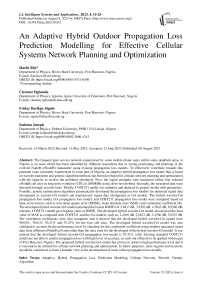An Adaptive Hybrid Outdoor Propagation Loss Prediction Modelling for Effective Cellular Systems Network Planning and Optimization
Автор: Ikechi Risi, Clement Ogbonda, Friday Barikpe Sigalo, Isabona Joseph
Журнал: International Journal of Intelligent Systems and Applications @ijisa
Статья в выпуске: 4 vol.15, 2023 года.
Бесплатный доступ
The frequent poor service network experienced by some mobile phone users within some deadlock areas in Nigeria is an issue which has been identified by different researchers due to wrong positioning and planning of the evolved NodeB (eNodeB) transmitter using existing propagation loss models. To effectively contribute towards this potential issue constantly experienced in some part of Nigeria, an adaptive hybrid propagation loss model that is based on wavelet transform and genetic algorithm methods has been developed for cellular network planning and optimization, with the capacity to resolve the problems absolutely. First, the signal strengths were measured within four selected eNodeB cell sites in long term evolution (LTE) at 2600MHz using drive-test method. Secondly, the measured data were denoised through wavelet tools. Thirdly, COST231 model was optimize and deduced to generic model with parameters. Fourthly, genetic optimization algorithm automatically developed the propagation loss models for denoised signal data (designated as wavelet-GA model) and unprocessed signal data (designated as GA model). The hybrid wavelet-GA propagation loss model, GA propagation loss model, and COST231 propagation loss model were compared based on three error metrics such as root mean square error (RMSE), mean absolute error (MAE) and correlation coefficient (R). The developed hybrid wavelet-GA model estimated the lowest RMSEs of 2.8813 dB, 3.9381 dB, 4.7643 dB, 6.9366 dB, whereas, COST231 model gave highest value of RMSE. The developed hybrid wavelet-GA model also derived the least value of MAE as compared with COST231 and the GA models, such as, 2.2016 dB, 2.8672 dB, 3.4766 dB, 5.8235 dB. The correlation coefficients were also compared, and it showed that the developed hybrid wavelet-GA model were 90.04%, 78.61%, 92.21% and 91.23% for the four cell sites. The developed hybrid wavelet-GA model was also validated to account for the performance level by checking for the correlation coefficient using another measured signal data from different eNodeB cell sites other than the once used for the developed of the hybrid wavelet-GA model. It was noticed that the developed hybrid wavelet-GA propagation loss model is 97.41% valid. Existing standard COST231 model are not able to predict propagation loss with high level of accuracy, as such not efficient to be applied within part of Port Harcourt, Nigeria. The proposed hybrid wavelet-GA model has proven to achieve high performance level and it is relevant to be utilized for cellular network planning and optimization. In future purposes, more regions and locations should be considered to form a broader view in the development of more robust propagation loss models.
Adaptive, Hybrid, Propagation Loss, Prediction Modeling, Cellular Network, Wavelet, Genetic Algorithm
Короткий адрес: https://sciup.org/15019003
IDR: 15019003 | DOI: 10.5815/ijisa.2023.04.02
Список литературы An Adaptive Hybrid Outdoor Propagation Loss Prediction Modelling for Effective Cellular Systems Network Planning and Optimization
- Z. K. Adeyemo and O. K. Ogunremi. Genetic algorithm based pathloss optimization for Long Term Evolution in Lagos, Nigeria. International journal of applied science and technology, 6(2), 79–88, 2016
- M. Atenaga. On the compromise between network performance and end-user satisfaction over UMTS radio interface : an empirical investigation. International journal of advanced research in physical science, 1(8), 9-18, 2014
- P. Atanasov and Z. Kissovski. Optimization of path loss models based on signal level measurements in 4G LTE network in Sofia. Bulgaria journal of physics, 44(5), 145–154, 2017
- A. Bhuvaneshwari, R. Hemalatha and T. SatyaSavithri. Path Loss Model Optimization Using Stochastic Hybrid Genetic Algorithm. International Journal of Engineering & Technology, 7(4), 464-469, 2018
- M. Ekpenyong. Modeling the effect of dropped calls on cell traffic in established 3G based cellular networks modeling the effect of dropped calls on cell traffic in established 3g-based cellular networks. African journal of computing & ICT, 34(5), 157-164, 2014
- A. Etinger, Y. Golovachev, O. Shoshanim, G. A. Pinhasi and Y. Pinhasi. Experimental study of fog and suspended water effects on the 5G millimeter wave communication channel. Electronics (switzerland), 9(5), 1-17, 2020. https://doi.org/10.3390/electronics9050720
- F. Ikegami and S. Yoshida. Analysis of multipath propagation structure in urban mobile radio environments. IEEE transactions on antenna and propagation, 28(4), 531-537, 1980
- J. Isabona and V. M. Srivastava. User-centric methodology for objective assessment of service quality in established Wireless Mobile Communication Networks. International journal on communications, antenna and propagation, 7(1), 26–30, 2017. https://doi.org/10.15866/irecap.v7i1.10475
- J. Isabona and R. Kehinde. Multi-resolution based Discrete Wavelet Transform for Enhanced Signal Coverage Processing and Prediction Analysis, Journal of sciences, 3 (1), 6-15, 2019
- W. N. W. Ismail and W. Z. W. Zin. Estimation of rainfall and stream flow missing data for Terengganu , Malaysia by using interpolation technique methods. Malaysian Journal of fundamental and applied sciences, 13(3), 213–217, 2017
- A. Khare, M. Saxena and S. Tiwari. Multimedia networks based dynamic WCDMA system proposal for QoS. International journal of engineering and advanced technology, 1(1), 52–55, 2011
- D. D. E. Michel and T. Emmanuel. Optimization of Okumura-Hata Model in 800MHz based on Newton Second Order algorithm. Case of Yaoundé, Cameroon. Journal of Electrical and Electronics Engineering, 10(2), 16-24, 2015
- D. O. Ojuh and J. Isabona. Optimum signal denoising based on wavelet shrinkage thresholding techniques: white gaussian noise and white uniform noise case study. Journal of scientific and engineering research, 5(6), 179-186, 2018
- K. J. Parmar and V. D. Nimavat. Comparative analysis of path loss propagation models in radio communication. International journal of innovative research in computer and communication engineering, 3(2), 840-844, 2015
- D. Sharma. The Effect of path loss on QoS at NPL. International Journal of Engineering Science and Technology, 2(7), 3018–3023, 2010
- S. Saunders and A. Zavala. Antenna and propagation for wireless communication systems. Weley, 6(4),1-553, 2007


